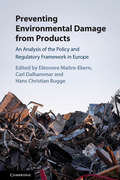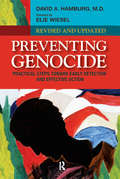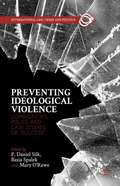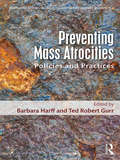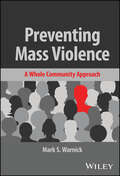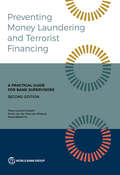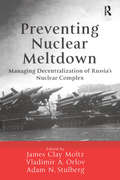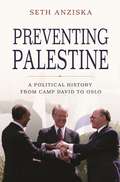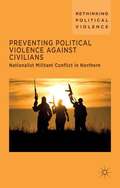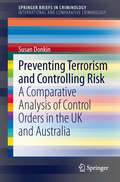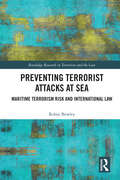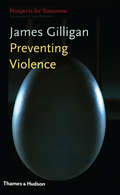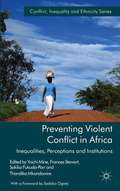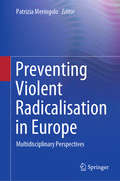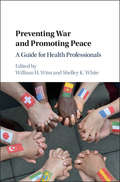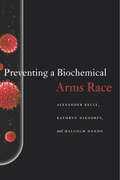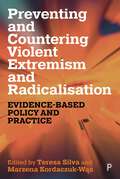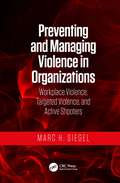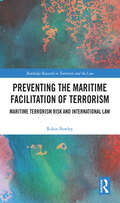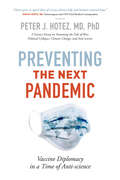- Table View
- List View
Preventing Environmental Damage from Products: An Analysis Of The Policy And Regulatory Framework In Europe
by Carl Dalhammar Hans Christian Bugge Eléonore Maitre-EkernHow to tackle environmental damage from the throwaway society is one of the defining questions of the twenty-first century. By establishing a circular economy, we can encourage and support sustainable production and consumption. <P><P>These essays by an international group of leading scholars from a range of disciplines analyse policies and legal instruments and challenge mainstream assumptions, from the choice of a policy mix to the actual effect of imposing standards on the market, and from corporate objectives and priorities to the use of precaution in assessing particularly harmful substances. <P>Each chapter contributes to a better understanding of the current policy and regulatory framework in Europe and identifies the challenges and opportunities ahead. The book breaks new ground by examining how product policies can contribute to important objectives and visions, such as the aims of the circular economy. It is a must-read for researchers as well as for policymakers and practitioners.<P> Explores a very topical but under-researched field.<P> Opens new perspectives on environmental product regulation.<P> Illustrates arguments with concrete examples from the law and from the practice.
Preventing Genocide: Practical Steps Toward Early Detection and Effective Action
by David A. HamburgGenocide has been called 'a problem from hell' and despite vehement declarations of 'never again' it's a problem that continues to plague the world. From the beginning of history to the most recent massacres in Bosnia, Rwanda, and Darfur, genocide defies resolution. And given today's worldwide access to highly lethal weapons and advanced communications technology facilitating incitement to hate, we can expect to see this problem grow. It is often claimed that genocide occurs without warning, taking both local and global communities by surprise. Yet, as David Hamburg convincingly shows, we have had long-term advance knowledge of most modern genocides dating back to the early 20th century Armenian tragedy in Turkey and before. In this book, Dr. Hamburg applies a groundbreaking new perspective-the medical model of prevention-to the scourge of genocide in the world. Preventing genocide is not only possible, Dr Hamburg contends, but essential given its high cost in lives, human rights, and international security. Here he maps out numerous practical steps to recognise genocidal conflicts early and stem their tides of violence before they become acute. He also outlines several institutions in place and programs underway at the UN, EU, and NATO devoted to preventing future genocides before they erupt. He draws lessons both from missed opportunities and successful experiences and makes many constructive suggestions about strengthening international institutions, governments, and NGOs for this purpose.
Preventing Ideological Violence
by Basia Spalek P. Daniel Silk Mary O’raweThis book presents the voices of police and community members who have been involved in engagement and partnership projects designed for countering violent extremism. Though the threat of the so-called Islamic State garners a great deal of current attention, the book explores ideological violence prevention efforts in a number of contexts, to include that of paramilitary organizations as well as Qa'ida inspired actors.
Preventing Mass Atrocities: Policies and Practices (Routledge Studies in Genocide and Crimes against Humanity)
by Barbara Harff Ted Robert GurrWhat can be done to warn about and organize political action to prevent genocide and mass atrocities? The international contributors to this volume are either experts or practitioners, often both, who have contributed in substantial ways to analyzing high risk situations, recommending preventive policies and actions, and in several instances helping to organize remedial actions. Whereas current literature on the prevention of genocide is theoretically well grounded, this book explores what can be done, and has been done, in real-world situations. Recommendations and actions are rooted in a generation of experience, based on solid historical, comparative, and empirical research and with a grounding in quantitative methods. This volume examines historical cases to understand the general causes and processes of mass violence and genocide, and engages with ongoing genocidal crises including Darfur and Syria, as well as other forms of related violence such as terrorism and civil conflict. It will be key reading for all students and scholars of genocide, war and conflict studies, human security and security studies in general.
Preventing Mass Violence: A Whole Community Approach
by Mark S. WarnickBuild your community's ability to be proactive toward preventing mass violence In the past decade, communities across America have grappled with an alarming surge in mass violence incidents, leaving citizens and authorities alike seeking effective prevention strategies. In Preventing Mass Violence: A Whole Community Approach, Dr. Mark S. Warnick draws on his extensive experience as a first responder to provide a comprehensive blueprint for thwarting mass shootings, terrorist acts, and other large-scale violence. Emphasizing a collaborative "whole community" model, Warnick advocates for robust cooperation among law enforcement, emergency services, businesses, schools, healthcare providers, and the public. Through actionable insights, readers will discover practical methods to cultivate resilience and deter various forms of violence, from mass shootings to vehicular attacks. With a focus on prevention, the book equips readers with strategies to identify and address concerning behaviors, empowering law enforcement agencies and other stakeholders to navigate operational challenges effectively. Tailored for law enforcement professionals, public safety workers, healthcare personnel, educators, local governments, and organizations with emergency protocols, Preventing Mass Violence is an indispensable resource for safeguarding communities and mitigating the profound human and economic toll of such incidents.
Preventing Money Laundering and Terrorist Financing, Second Edition: A Practical Guide for Bank Supervisors
by Pierre-Laurent Chatain Emile van der Does de Willebois Maud BökkerinkMoney laundering and terrorist financing undermine the integrity and stability of financial systems and can have a significantly adverse impact on a jurisdiction's economy. Challenges to effective supervision and prevention of money laundering and financing of terrorism were exacerbated in the aftermath of the 2008 financial crisis, with financial institutions' need for funds at times undermining vigilance as to the provenance of those funds. As such, supervisors often, and prudently, focused on coping with the crisis. Since 2009, when the first edition of this handbook was published, challenges to the integrity and stability of financial systems have continued to evolve. Money-laundering and terrorist-financing risks continue to threaten the reputations of financial institutions and entire financial sectors, exposing institutions to the possibility of severe enforcement action by public authorities or the loss of correspondent relationship facilities by their private sector counterparts. This second edition reflects the evolving challenges to the integrity and stability of financial systems, recent trends in enforcement actions by country authorities, and changes to international standards, notably an emphasis on a risk-based approach. This practical handbook supports the implementation of international standards established by the Financial Action Task Force and other bodies, * Providing examples of money-laundering and terrorist-financing supervisory frameworks in a range of countries; * Describing best practices for the supervision and enforcement of money-laundering and terrorist-financing laws and regulations; * Offering practical advice on how a particular jurisdiction might incorporate enforcement of the laws and regulations on money laundering and terrorist financing into its supervisory framework. Designed specifically for bank supervisors, this guide will also be of interest to readers working in the areas of finance, corruption prevention, law, accounting, and corporate governance.
Preventing Nuclear Meltdown: Managing Decentralization of Russia's Nuclear Complex
by James Clay Moltz Adam N. Stulberg Vladimir A. OrlovThe decline in central financing for Russia's nuclear complex and the known interest of terrorist groups in acquiring fissile material and technologies, has made the state of Russia's far-flung nuclear enterprises a pressing international issue. In this important volume, a group of leading US and Russian policy experts - drawing on extensive interviews with officials, facility personnel, and analysts in Russia's regions - explores the intersecting problems of Russian nuclear insecurity and decentralization, including the growing influence of regional, political and economic forces. The work presents insights into both nuclear safety issues and post-Soviet intra-agency governance, as well as detailed case studies of critical nuclear regions: the Far East, the Urals, Siberia, and the Volga area. The volume also offers major new findings on the interface linking Russia's evolving center-periphery relations, its ailing nuclear facilities, and the role played by foreign assistance providers.
Preventing Palestine: A Political History from Camp David to Oslo
by Seth AnziskaOn the fortieth anniversary of the Camp David Accords, a groundbreaking new history that shows how Egyptian-Israeli peace ensured lasting Palestinian statelessnessFor seventy years Israel has existed as a state, and for forty years it has honored a peace treaty with Egypt that is widely viewed as a triumph of U.S. diplomacy in the Middle East. Yet the Palestinians—the would-be beneficiaries of a vision for a comprehensive regional settlement that led to the Camp David Accords in 1978—remain stateless to this day. How and why Palestinian statelessness persists are the central questions of Seth Anziska’s groundbreaking book, which explores the complex legacy of the agreement brokered by President Jimmy Carter.Based on newly declassified international sources, Preventing Palestine charts the emergence of the Middle East peace process, including the establishment of a separate track to deal with the issue of Palestine. At the very start of this process, Anziska argues, Egyptian-Israeli peace came at the expense of the sovereignty of the Palestinians, whose aspirations for a homeland alongside Israel faced crippling challenges. With the introduction of the idea of restrictive autonomy, Israeli settlement expansion, and Israel’s 1982 invasion of Lebanon, the chances for Palestinian statehood narrowed even further. The first Intifada in 1987 and the end of the Cold War brought new opportunities for a Palestinian state, but many players, refusing to see Palestinians as a nation or a people, continued to steer international diplomacy away from their cause.Combining astute political analysis, extensive original research, and interviews with diplomats, military veterans, and communal leaders, Preventing Palestine offers a bold new interpretation of a highly charged struggle for self-determination.
Preventing Political Violence Against Civilians: Nationalist Militant Conflict in Northern Ireland, Israel and Palestine (Rethinking Political Violence)
by Aoibhín De BúrcaThe increased targeting of civilians by militants raises serious and profound questions for policy-makers. Examining conflict in Northern Ireland, Israel and Palestine, this book focuses on ethno-nationalist militant groups and formulates a model to constrain violence against civilians.
Preventing Regulatory Capture
by David A. Moss Daniel CarpenterWhen regulations (or lack thereof) seem to detract from the common good, critics often point to regulatory capture as a culprit. In some academic and policy circles it seems to have assumed the status of an immutable law. Yet for all the ink spilled describing and decrying capture, the concept remains difficult to nail down in practice. Is capture truly as powerful and unpreventable as the informed consensus seems to suggest? This edited volume brings together seventeen scholars from across the social sciences to address this question. Their work shows that capture is often misdiagnosed and may in fact be preventable and manageable. Focusing on the goal of prevention, the volume advances a more rigorous and empirical standard for diagnosing and measuring capture, paving the way for new lines of academic inquiry and more precise and nuanced reform.
Preventing Terrorism and Controlling Risk
by Susan DonkinThis Brief takes a provocative look at existing socio-legal literature with a comparative study of terrorism control orders, focusing on how the concept of pre-emption fits within a traditional criminological framework. This timely work examines how such measures might be conceived and interpreted within a situational crime prevention approach. Over the past decade, socio-legal scholars have identified a rise in pre-emptive control mechanisms to respond to terrorism and other threats in the post-9/11 world. Many have argued that this pre-emptive rationale has been used to justify the introduction of measures that transcend established legal and risk frameworks, to deal with individuals or groups thought to pose a threat to the state or its citizens. Preventing Terrorism and Controlling Risk: A Comparative Analysis of Control Orders in the UK and Australia will be of interest to researchers in Criminology and Criminal Justice, particularly with a focus on terrorism, risk assessment, and human rights.
Preventing Terrorist Attacks at Sea: Maritime Terrorism Risk and International Law (Routledge Research in Terrorism and the Law)
by Robin BowleyOver recent decades, it has been widely recognised that terrorist attacks at sea could result in major casualties and cause significant disruptions to the free flow of international shipping. After discussing the overlaps and distinctions between piracy and maritime terrorism, this book considers how the International Ship and Port Facility Security Code, and other vessel identification and tracking measures in the 1974 International Convention for the Safety of Life at Sea, would be likely to reduce the risk of terrorist attacks at sea. It explains how the 1982 United Nations Convention on the Law of the Sea is less than clear on the powers of states to protect offshore installations, submarine cables and pipelines from interference by terrorists. In light of these uncertainties, it considers how the 2005 Protocol to the Convention for the Suppression of Unlawful Acts Against Maritime Navigation, the doctrine of necessity and states’ inherent self-defence rights might apply in the maritime security context. A significant contribution of the book is the formulation of the Maritime Terrorism Threat Matrix, which provides a structured framework for examining how maritime terrorism incidents have occurred, and might occur in the future. The book also examines the relevant national maritime security legislation for preventing maritime terrorist attacks in the United Kingdom and in Australia. The book concludes by formulating guidelines for the unilateral interdiction of suspected terrorist vessels in exceptional circumstances, and recommending priorities for governments and international maritime industries to focus on in order to reduce the risk for terrorist attacks at sea. It will be of interest to those working in the areas of Law and Terrorism, Law of the Sea, Maritime Law and Insurance and International Law.
Preventing Violence (Prospects for Tomorrow)
by James GilliganIn this controversial and compassionate book, the distinguished psychiatrist James Gilligan proposes a radically new way of thinking about violence and how to prevent it. Violence is most often addressed in moral and legal terms: "How evil is this action, and how much punishment does it deserve?" Unfortunately, this way of thinking, the basis for our legal and political institutions, does nothing to shed light on the causes of violence. Violent criminals have been Gilligan's teachers, and he has been their student. Prisons are microcosms of the societies in which they exist, and by examining them in detail, we can learn about society as a whole. Gilligan suggests treating violence as a public health problem. He advocates initiating radical social and economic change to attack the root causes of violence, focusing on those at increased risk of becoming violent, and dealing with those who are already violent as if they were in quarantine rather than in constraint for their punishment and for society's revenge. The twentieth century was steeped in violence. If we attempt to understand the violence of individuals, we may come to prevent the collective violence that threatens our future far more than all the individual crimes put together.
Preventing Violent Conflict in Africa
by Yoichi MineHorizontal inequalities are root causes of violent conflict in Africa. Yet, people take actions not because of statistical data on inequalities, of which they might not be aware, but because of injustices they perceive. This volume analyses the results of original surveys with over 3,000 respondents in African cities and towns, exposing clear discrepancies between objective inequalities and people's subjective perceptions. The contributors examine experiences in country pairs and probe into the reasons why neighbouring countries, sharing common historical traits, sometimes took contrasting pathways of peace and violent conflict. Combining quantitative analysis and qualitative anatomy of historical experiences of conflict and reconciliation in Rwanda, Burundi, Ghana, C#65533;te d'Ivoire, South Africa, Zimbabwe, Uganda, Tanzania, Kenya and Nigeria, the study brings forward a set of policy recommendations for development practitioners. This work further addresses the issue of institutional choice and reveals how sustainable power-sharing and decentralisation contribute to political stability in Africa.
Preventing Violent Radicalisation in Europe: Multidisciplinary Perspectives
by Patrizia MeringoloThis book brings together the latest literature and European experiences on preventing youth violent radicalisation and violent actions in intergroup relations. Youth violent radicalisation is a significant problem within the European context, and requires an exploration of how various social actors can play an active role in preventing radicalisation in minors and young adults. This complex issue needs to be explored through a multidisciplinary approach, and effective operational models are needed in order to tackle it. This book describes the theoretical framework for such an approach in all its facets. The book’s originality lies in its psychosocial and participatory approach, aimed at improving results through professional training and community empowerment for building trusting relationships and educational activities. It also proposes “alternative narratives”, which are a way of representing people and groups within a social context, thereby overcoming stereotyped visions and stigma. This book focuses on participation and communication among stakeholders, social inclusion, strengthening democratic values, and pursuing a proactive instead of a reactive approach to preventing radicalisation. Highly topical, the book will appeal to researchers and students of the social and behavioural sciences interested in youth radicalisation, including social work and social policy, as well as practitioners working within the juvenile justice system.
Preventing War and Promoting Peace: A Guide for Health Professionals
by William H. Wiist Shelley K. WhitePreventing War and Promoting Peace: A Guide for Health Professionals is an interdisciplinary study of how pervasive militarism creates a propensity for war through the influence of academia, economic policy, the defense industry, and the news media. Comprising contributions by academics and practitioners from the fields of public health, medicine, nursing, law, sociology, psychology, political science, and peace and conflict studies, as well as representatives from organizations active in war prevention, the book emphasizes the underlying preventable causes of war, particularly militarism, and focuses on the methods health professionals can use to prevent war. Preventing War and Promoting Peace provides hard-hitting facts about the devastating health effects of war and a broad perspective on war and health, presenting a new paradigm for the proactive engagement of health professions in the prevention of war and the promotion of peace.
Preventing War: The United Nations and Macedonia
by Abiodun WilliamsDescribes the role the UN played in Macedonia.
Preventing a Biochemical Arms Race
by Alexander Kelle Kathryn Nixdorff Malcolm DandoPreventing a Biochemical Arms Raceresponds to a growing concern that changes in the life sciences and the nature of warfare could lead to a resurgent interest in chemical and biological weapons (CBW) capabilities. By bringing together a wide range of historical material and current literature in the field of CBW arms control, the book reveals how these two disparate fields might be integrated to precipitate a biochemical arms race among major powers, rogue states, or even non-state actors. It seeks to raise awareness among policy practitioners, the academic community, and the media that such an arms race may be looming if developments are left unattended, and to provide policy options on how it - and it's devastating consequences - could be avoided. After identifying weaknesses in the international regime structures revolving around the Biological Weapons and Chemical Weapons Conventions, it provides policy proposals to deal with gaps and shortcomings in each prohibition regime individually, and then addresses the widening gap between them.
Preventing and Countering Extremism and Terrorist Recruitment: A Best Practice Guide
by Hanif QadirHanif Qadir is recognised as one of the world's leading specialists in positively transforming violent extremists. He has worked with hundreds of high-risk terrorist and violent extremist cases and has challenged many known figureheads who lead violently extreme groups both at home and abroad. In this essential book for all those who work with young people, Hanif outlines the push and pull factors and the early indicators of radicalisation, and offers decisive and unambiguous advice on how and when to intervene. The book includes anonymous case studies of a wide variety of people Hanif has personally worked with and lays down simple lessons on what success and failure looks like when tackling extremism.
Preventing and Countering Extremism and Terrorist Recruitment: A Best Practice Guide
by Hanif QadirHanif Qadir is recognised as one of the world's leading specialists in positively transforming violent extremists. He has worked with hundreds of high-risk terrorist and violent extremist cases and has challenged many known figureheads who lead violently extreme groups both at home and abroad. In this essential book for all those who work with young people, Hanif outlines the push and pull factors and the early indicators of radicalisation, and offers decisive and unambiguous advice on how and when to intervene. The book includes anonymous case studies of a wide variety of people Hanif has personally worked with and lays down simple lessons on what success and failure looks like when tackling extremism.
Preventing and Countering Violent Extremism and Radicalisation: Evidence-Based Policy and Practice
by Michael Lewis Jerzy Sarnecki Jane L. Ireland Leena Malkki Gustav Grut Sören Henrich Erin Lawlor Gema Varona Irina Van Der Vet Simon Fulgoni Susanna MenisEPUB and EPDF available open access under CC-BY-NC-ND licence. How can we use evidence to improve deradicalisation and violence prevention outcomes? Based on work developed during the implementation of the cross-European INDEED project, this is an essential reference book for practitioners, researchers and policy makers. It sets out the three pillars of best evidence-based practice – scientific evidence, professional judgement and consideration of clients’ preferences, values and beliefs. Demonstrating both successful and unsuccessful approaches with case studies from the field, the book offers practical strategies for prevention teams designing and evaluating their programmes.
Preventing and Countering Violent Extremism: Designing and Evaluating Evidence-Based Programs (Political Violence)
by Michael J. WilliamsThis textbook serves as a guide to design and evaluate evidence-based programs intended to prevent or counter violent extremism (P/CVE). Violent extremism and related hate crimes are problems which confront societies in virtually every region of the world; this text examines how we can prevent or counter violent extremism using a systematic, evidence-based approach. The book, equal parts theoretical, methodological and applied, represents the first science-based guide for understanding “what makes hate,” and how to design and evaluate programs intended to prevent this. Though designed to serve as a primary course textbook, the work can readily serve as a how-to guide for self-study, given its abundant links to freely available online toolkits and templates. As such, it is designed to inform both students and practitioners alike with respect to the management, design, or evaluation of programs intended to prevent or counter violent extremism. Written by a leading social scientist in the field of P/CVE program evaluation, this book is rich in both scientific rigor and examples from the “real world” of research and evaluation dedicated to P/CVE. This book will be essential reading for students of terrorism, preventing or countering violent extremism, political violence, and deradicalization, and highly recommended for students of criminal justice, criminology, and behavioural psychology.
Preventing and Managing Violence in Organizations: Workplace Violence, Targeted Violence, and Active Shooters
by Marc H. SiegelOrganizations of all types and sizes, whether they are a business, educational institution, healthcare provider, or house-of-worship, need to plan for the possibility of violent acts that may impact its people, assets, and activities. Preventing and Managing Violence in Organizations: Workplace Violence, Targeted Violence, and Active Shooters provides a comprehensive approach to addressing workplace violence, active shooter and assailant events, and other forms of targeted violence. The book takes a unique perspective that the prevention and management of violence in an organization is a risk and business management issue, rather than a siloed security issue. As such, the book’s objective is to help organizations develop a program for preventing and managing violence that can be integrated into their day-to-day overall business management approach. The main theme of the book is that any program to prevent and manage violence in an organization needs to be an inclusive process: where everyone in the organization is viewed as a risk maker and risk taker, and therefore, a risk manager. The emphasis is on building a risk and security awareness culture in the organization so that everyone throughout the organization is aware and part of the solution. The book recognizes that many, if not most, organizations do not have a dedicated chief security officer to oversee the prevention and management of violence. It also recognizes that many resource allocation decisions are made by business managers, not the security manager. While other books approach this issue from a security perspective, this book takes the perspective that providing a safe and secure environment within the organization, and protecting its people, assets, and activities, is a business management imperative. Therefore, the book emphasizes the need to promote a risk and security awareness culture that is integrated into the organization's system of management and all its activities and functions. The "Introduction" section of the book includes a brief description of violence in organizations and the imperative for integrating the prevention and management of violence into the organization’s overall business management strategy. The "Framework" section helps business, human resource, risk, security, and safety managers build a programmatic framework to support prevention and management of violence in all the organizations activities. The "Tactics and Control Measures" section provides tactical and operational advice and tools on methods to prevent, respond to, and recover from potentially violent events. For organizations that have adopted an ISO, Robust Process Improvement, or Six-Sigma management systems approach, they will immediately recognize that the elements described in the framework can be integrated seamlessly into their overall management system approach. Preventing and Managing Violence in Organizations illustrates a systems approach for preventing and managing violence in organizations that can also be used for managing other types of operational risks. Security managers will find the book useful for integrating security in the organization’s day-to-day activities—as an integral part of these activities—rather than an add-on activity. Security professionals will be able to present their program from a business and risk management perspective.
Preventing the Maritime Facilitation of Terrorism: Maritime Terrorism Risk and International Law (Routledge Research in Terrorism and the Law)
by Robin BowleyIn the aftermath of the 9/11 attacks, concerns that terrorists might utilise vessels to transport weaponry, terrorist operatives and/or to finance their activities prompted several international legal developments. This book evaluates the extent to which the international maritime security measures developed following the 9/11 attacks would be likely to prevent the utilisation of vessels to facilitate terrorist activities. It considers the likely effectiveness of the International Ship and Port Facility Security Code for improving vessel and port security, and the 2005 Protocol to the Convention for the Suppression of Unlawful Acts Against Maritime Navigation in facilitating the interdiction of suspected terrorist vessels. It also explains how the US-led Proliferation Security Initiative - a cooperative effort through which participant governments agree to prevent the illicit transfers of Weapons of Mass Destruction and related materials – has provoked debate about the legality of vessel interdictions under the United Nations Convention on the Law of the Sea (the LOSC). After exploring alternative interpretations of the LOSC, and states’ self-defence rights under Article 51 of the Charter of the United Nations, it formulates suggested guidelines for the unilateral interdiction of suspected terrorist support vessels in exceptional circumstances. The book also discusses the relevant recommendations by the OECD’s Financial Action Taskforce for preventing the financing of terrorism, and the national maritime security legislation for preventing the maritime facilitation of terrorist activities in the United Kingdom and in Australia. The book concludes by emphasising the importance of the continual active implementation of ship, port facility and supply chain security measures, and of further enhancing international cooperation to facilitate vessel interdictions. It will be of interest to those working in the areas of Law and Terrorism, Law of the Sea, Maritime Law and Insurance and International Law.
Preventing the Next Pandemic: Vaccine Diplomacy in a Time of Anti-science
by Peter J. HotezThe last five years saw a significant return of epidemic infectious disease, culminating in COVID-19. In our new post–COVID-19 world, how do we prevent future illnesses by expanding scientific and vaccine diplomacy and cooperation, especially to combat the problems that humans have brought on ourselves?Modern diseases and viruses have been spurred anew by war and conflict as well as shifting poverty, urbanization, climate change, and a new troubling anti-science/anti-vaccination outlook. From such twenty-first-century forces, we have seen declines in previous global health gains, with sharp increases in vaccine-preventable and neglected diseases on the Arabian Peninsula, in Venezuela, in parts of Africa, and even on the Gulf Coast of the United States. In Preventing the Next Pandemic, international vaccine scientist and tropical disease and coronavirus expert Peter J. Hotez, MD, PhD, argues that we can—and must—rely on vaccine diplomacy to address this new world order in disease and global health. Detailing his years in the lab developing new vaccines, Hotez also recounts his travels around the world to shape vaccine partnerships with people in countries both rich and poor in an attempt to head off major health problems. Building on the legacy of Dr. Albert Sabin, who developed the oral polio vaccine with Soviet scientists at the height of the Cold War, he explains how he is still working to refresh and redirect vaccine diplomacy toward neglected and newly emerging diseases. Hotez reveals how—during his Obama-era tenure as the US Science Envoy for the Middle East and North Africa, which coincided with both the rise in these geopolitical forces and climate change—he witnessed tropical infectious diseases and established vaccine partnerships that may still combat them up close. He explores why, since 2015, we've seen the decline of global cooperation and cohesion, to the detriment of those programs that are meant to benefit the most vulnerable people in the world. Unfortunately, Hotez asserts, these negative global events kick off a never-ending loop. Problems in a country may lead to disease outbreaks, but those outbreaks can lead to further problems—such as the impact of coronavirus on China's society and economy, which has been felt around the globe. Zeroing in on the sociopolitical and environmental factors that drive our most controversial and pressing global health concerns, Hotez proposes historically proven methods to soothe fraught international relations while preparing us for a safer, healthier future. He hammers home the importance of public engagement to communicate the urgency of embracing science during troubled times. Touching on a range of disease, from leishmaniasis, schistosomiasis, and Middle East Respiratory Syndrome (MERS) to COVID-19, Preventing the Next Pandemic has always been a timely goal, but it will be even more important in a COVID and post-COVID world.
